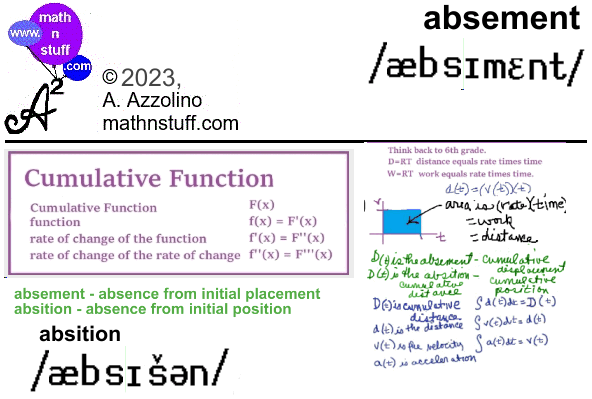

mathnstuff.com/math/spoken/here/1words/a/absement.htm |

|
COMMENT: Yes, it is a "new" word. No! it is not a new idea. Dr. Steve Mann, the “the father of wearable computing,” from the University of Toronto, and a colleague coined the term absement for the time integral of displacement.[0] IN MATH: 1. n. total distance from start, cumulative or total displacement (absence from initial placement),
distance (absition from absence from initial position),
2. n. the anitderivative of displacement or distance, the absition. SEE THE TABLE
BELOW. IN ENGLISH: there is no definition or "nonmath" use. APPLICATION: Calculus. QUESTIONS Swipe, with the mouse, between the stars to see the answer. 1. If this discussion were about probability rather than displacement or distance what is the name of the function that serves the same purpose as the absement?
STUFF YOU MAY WISH: See Dynamic Geometry absement SketchPad, pdf of this page. |
|
Mathematics, Kenimatics
|
|
The n-th derivatives of displacement
(displacement and its derivatives and antiderivatives/integrals) where the distance unit is the meter [6]
|
In studying the fragment of history that led to the names for the nth derivatives, start with Roman numerals and Latin letters.
In the mid1800s, chemists used small units (centimeters, grams, seconds) and engineers used large units (meter, kilogram, and second). When the Metric System was extend, it had toinclude all of these and more.[7] Use the prefix ab meaning “away.” "Other words with this prefix are: absent, abduct, and absolute. For example: Absent describes someone who is absent is “away” from a place.[8] As more units were needed, the naming became a bit quirky as with the naming of subatomic elementary particles of the Standard Model. The six "flavors" of quarks: up, down, strange, charm, bottom, and top. [9] Even Kellog's Rice Krispies Cereal [10] sounds, snap, crackle, and pop are found in the names of the nth-derivatives. The metric practice of using powers of ten and symmetry of names, large reflecting small for a specific power of 10, is used in naming the antiderivatives, the negative power nth derivatives. |
| |||||||||||||||||||||||||||||||||||||||||||||||||||||||||||||||||||||||||||||||||||||||||||||||||||||||||||||||||||||||||||||||||||||||||||||||||||||||||||||||||||||||||||||||||||||||||||||||||||||||||||||||||||||||||||||||||||||||||||||
|
[6] https://en.wikipedia.org/wiki/Absement [7] https://www.ibiblio.org/units/cgsmks.html [8] https://membean.com/roots/ab-away [9] https://en.wikipedia.org/wiki/Subatomic_particle#Hadrons [10] https://www.ricekrispies.com/en_US/products/cereal.html [11] Metric Prefixes & Conversion | |||||||||||||||||||||||||||||||||||||||||||||||||||||||||||||||||||||||||||||||||||||||||||||||||||||||||||||||||||||||||||||||||||||||||||||||||||||||||||||||||||||||||||||||||||||||||||||||||||||||||||||||||||||||||||||||||||||||||||||||


mathnstuff.com/math/spoken/here/1words/a/absement.htm |